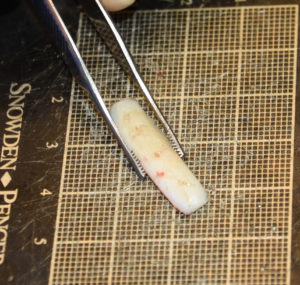
In the Online First Section of the November/December 2014 issue of the JAMA Facial Plastic Surgery journal, an article was published entitled ‘Complications Associated With Autologous Rib Cartilage Use in Rhinoplasty – A Meta-Analysis.’ In this paper, the authors performed a review of the potential complications associated with using autologous rib cartilage in rhinoplasty surgery. This was done by reviewing published articles on the topic from 1946 to 2013. Qualified papers included clinical studies with at least 10 patients and at least one after surgery complication from either the autologous rib recipient or donor site.
The paper included ten clinical studies with just under 500 patients. Using meta-analysis, the occurrence of recipient site complications include a 3% incidence of rib warping, a very low rate of rib resorption (0.2%), 0.4% for graft displacement, 0.6% for infection, and a 14% rate of revisional surgery. The occurrence of donor site complications included a 5% rate for poor chest donor site scarring and a 0% occurrence for pneumothorax.
This study did not necessarily reveal any new complications from using rib grafts in rhinoplasty but their various occurrences merit discussion. I was surprised that the warping of rib grafts was so low. Depending upon how you define the level of symptomatic warping, my experience is that is it somewhat higher than a few percent. Warping of ribs is a reflection of the donor site and the skill of shaping the harvested rib graft as well as the size of the rib graft. Rib graft resorption occurred very rarely and this is no surprise given the low cellularity and metabolic activity of this type of tissue. (the only rib grafts I have ever seen resorb is in the face of infection) Similarly, infection in nasal rib grafting was also very low. (I have actually only seen it occur twice)
Hypertrophic chest scarring was seen in one out of twenty patients (5%) and is probably a reflection of the predominant Asian population which undergoes this type of augmentative rhinoplasty. Skin type and length of the harvest incision are major determinants of this complication. Pneumothorax is the most feared complication in rib grafting harvesting for any reason but it really shouldn’t be as this paper shows. When grafts are taken at the subcostal rib area, the apex of the lung lies way above it and there is no risk of violating the lung pleura. When taken at the inframammary breast fold in women, which is much higher, the lung is directly underneath but even small pleural tears do not result in any obvious pneumothoraces.
Like all rhinoplasties, the revision rates are fairly high and adding a rib graft to it only adds to the potential for postoperative aesthetic issues. At a near 15% rate, revision rhinoplasty includes such issues as revising warped and malpositioned grafts as well as graft edging and projection issues. Adding projection of the tip also exposes the risks of nostril asymmetry and alar rm retraction.
Dr. Barry Eppley
Indianapolis, Indiana


